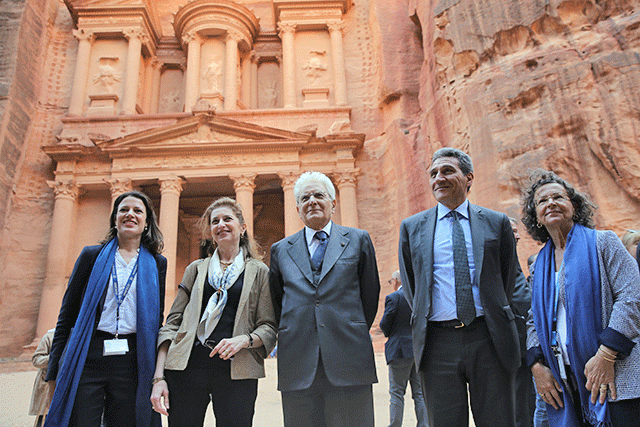You are here
UNESCO working with local residents to protect Petra
By JT - Jul 16,2014 - Last updated at Jul 16,2014

AMMAN — Residents of Um Sayhoun village in the south, and staff from the Department of Antiquities (DoA) and the Petra Archaeological Park (PAP) are now contributing to maintaining a World Heritage Site thanks to a UNESCO project.
The Siq, a mile-long gorge leading to the dramatic emergence of the Treasury, is a unique but fragile area, vulnerable to environmental risks, according to UNESCO.
Funded by Italian International Cooperation, UNESCO embarked on the implementation of a project titled “Siq Stability: Sustainable Monitoring Techniques for Assessing Instability of Slopes in the Siq of Petra”.
Through the project, which began in 2012, the Zamani Research Group from the University of Cape Town trained local residents on the use of a common geographic information system (GIS) for Petra, leading to long-term sustainability of the project.
“This is one of the most challenging projects in the world,” said Heinz Ruther, principal investigator of the Zamani Group and one of the trainers, warning his trainees that “while it is impossible to accurately laser scan the entire Siq, using GIS you can proactively improve upon the precarious nature of the Siq and the stones above [it].”
Using 144 marked Geographic Positioning System points, more than 2,000 scans and 500 panoramas, the group has crafted cross sections and panoramas of much of Petra, which lies some 235km south of Amman.
“Now I want to become a professional at GIS, and practice makes perfect,” said Areej Farajat, 26, a University of Jordan graduate who has been working in Wadi Musa for four years.
At the end of June, the documentation of the site was presented to the DoA.
The project was implemented in cooperation with other partners including the DoA, the Petra Development and Tourism Region Authority, the Italian Institute for Environmental Protection and Research, and Jordanian experts from the Petra National Trust.
“Funding this ambitious project, Italy has invested considerable financial resources to the safeguarding of Petra’s Siq and contributed… valuable specialised expertise in the field of geological hazards applied to cultural heritage,” UNESCO said.
“Italy’s widely recognised excellence in cultural heritage conservation offers an encouraging affirmation also in Jordan,” the agency added.
In December 2013, the United Nations General Assembly adopted a resolution on culture and development, which marked a turning point, acknowledging in detail the direct linkages between culture and the three pillars of sustainable development: economic, social and environmental.
“This was obvious in several initiatives that UNESCO is implementing in parallel with the Siq stability project,” the agency said.
Atef Al Fager is a Wadi Musa resident who benefited from one of these initiatives.
Fager, who grew up in a small village in Petra region and used to be called “the last bedouin in the world” by his friends, used to sell his wares to tourists from a small shop, perched near the Monastery at the end of the Petra tourist trek.
All that changed when he worked with UNESCO and became interested in rock climbing.
Through the Siq Stability project, Fager learned how to safely scale sheer surfaces in order to monitor the micro-prisms.
Produced in Italy, these prisms act as reflectors with special frames for historical building monitoring.
Fager can access these precariously placed devices with his new skills and can monitor the repeaters that gather wireless data, tracking crack-meters and other very technical equipment installed in six hazardous locations throughout the Siq.
He takes pictures of any changes as he traverses the Siq and these are sent to PAP and the UNESCO Amman office to monitor and provide maintenance or repair interventions when required.
Local residents used to smash the monitoring micro-prisms with rocks, suspicious that they were cameras. Since Fager became actively involved, he has been educating the community on the prisms and proudly explains, “If anyone messes with a prism, bedouins tell Atef.”
Global evidence has demonstrated that development policies responsibly rooted within specific cultural contexts yield stronger and more sustainable development outcomes, UNESCO said.
Married with two daughters, Fager and his small family now live in Um Sayhoun, a Bedouin village of 3,000 people.
“Now I work from my heart and I am more hopeful,” he said.
Working inside Jordan’s top tourist attraction is always stimulating and Fager stresses the importance of “reacting before the Siq suffers more damage” so travellers and residents can continue to enjoy the beauty of the Kingdom’s most valuable treasure for a long time to come.
Related Articles
AMMAN — UNESCO on Tuesday launched the second phase of the project “SIQ STABILITY — Mitigation of Immediate Hazards in the Siq of Petra” at
By Emily Bruser and Giorgia CesaroUNESCOAMMAN — With funding from the Italian government, the UNESCO Amman office is implementing a project
PETRA — Italian President Sergio Mattarella toured the ancient city of Petra on Thursday before concluding his official visit to Jordan.The



















